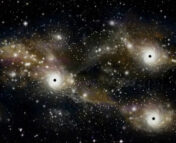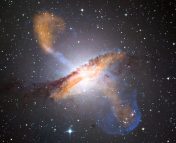Title: Tidal disruption events in the first billion years of a galaxy
Authors: Hugo Pfister, Jane Dai, Marta Volonteri, Katie Auchettl, Maxime Trebitsch, Enrico Ramirez-Ruiz
First Author’s Institution: DARK, Niels Bohr Institute, University of Copenhagen, Blegdamsvej 17, DK-2100 Copenhagen, Denmark and Department of Physics, The University of Hong Kong, Pokfulam Road, Hong Kong, China
Status: Submitted to the Monthly Notices of the Royal Astronomical Society, open access on arXiv
One Gyr in the Life of a Massive Black Hole
Massive black holes (MBHs) are known to live in the centers of most galaxies, including Sagittarius A* in our own Milky Way. These MBHs are intimately linked to the evolution and growth of their host galaxies (and vice versa), as evidenced by the M- relationship. However, the details of how MBHs are born and quickly grow to such gargantuan masses are still largely unknown.
There are two main channels for MBHs to grow throughout cosmic time, accretion and mergers. While it is thought that the majority of black hole growth is through accretion of gas, infalling gas is subject to heating processes called feedback. Considering this, gas accretion alone cannot fully explain the existence of extremely massive (more than a billion solar mass) black holes within the first billion years after the Big Bang. However, the accretion of stars is independent of feedback, thereby providing a way for MBHs to grow largely unimpeded in their early lives.
Shredded Stars
When a star passes too close to a MBH, the intense tidal forces of the black hole become stronger than the gravity holding the star together, and the star is ripped apart. This is known as a tidal disruption event (TDE), and in many cases produces a luminous flare of light. This allows us to observationally measure the rate of stars getting close enough to MBHs that they are eventually eaten up. Through continued studies over the past decade, it is known that the TDE rate is roughly 1 per 10,000 years per galaxy. Interestingly, both observations and theoretical simulations have suggested that TDE rates can be enhanced by galaxy mergers. For example, the TDE rate in E+A galaxies (a specific type of post-merger galaxy) is known to be up to a factor of 200 higher than in average galaxies.
In this paper, the authors set up a simulation to study the growth of MBHs and evolution of the TDE rate during the early universe. Their setup includes detailed physics on cosmology, gas cooling and heating, star formation, feedback from AGN and supernovae, black hole physics, and galactic dynamics. While these details are beyond the scope of this bite, the results of the simulations give clear insight into the growth of MBHs.
The Voracious Appetites of Young Black Holes
The mass growth of a MBH and its host galaxy are shown in Figure 1. The green line shows the growth of the MBH and the orange line shows the growth of the galaxy as a whole. Both grow quickly early in their life, increasing by a factor of ~100 in only 600 million years. The blue line shows the contribution of gas to the mass growth, whereas the black line is the stellar contribution in the form of TDEs. In their simulation, TDEs only contribute 0.2% of the total mass of the MBH, suggesting that the total contribution of TDEs is small. However, at early times and smaller black hole masses, the mass accretion from TDEs and gas are similar.

To better illustrate this point, the authors plot the ratio of TDE-related mass accretion to the total mass accretion, as shown in Figure 2. Very early in the life of the MBH, the contribution of TDEs and stellar accretion is actually larger than the gas accretion. In fact, in the first 300 million years, TDEs contribute to more than 10% of the mass growth of MBHs. By ~600 million years after the Big Bang however, the MBH is massive enough to accrete gas efficiently and the TDE contribution drops precipitously, becoming negligible by the end of the first billion years of the MBH’s life. This same concept can be seen as the black line flattens out in Figure 1, while the blue line increases rapidly.

Bumps in the Night
In addition to studying the growth of MBHs, the authors follow the TDE rate as a function of time. Figure 3 shows the TDE rate for several components (the central MBH in black, MBHs in merging galaxies in red and blue, and the total galaxy rate in orange). Early on, the TDE rate of the galaxy is dominated by TDEs on the central MBH. As mergers occur though, the TDE rates onto MBHs in merging galaxies become important to the total galaxy TDE rate.

Another interesting result of the author’s simulations is that by ~1 billion years after the Big Bang, the TDE rate is consistent with local observational rates. This may indicate that, in the absence of continued major mergers, the TDE rate in some galaxies may be established early in their lifetimes. Of observational interest is the fact that roughly 20% of the TDEs in this simulation occur around non-nuclear MBHs. Currently, due to contamination by supernovae, optical surveys exclude off-center sources when looking for TDEs. In the future, blind surveys may play an important role in finding non-nuclear TDEs and constrain the population of so-called wandering black holes.
In summary, the authors have found that over the course of the life of a MBH, TDEs and stellar accretion do not play a major role. Nonetheless, it is clear that in the initial stages of growth, TDEs provide a means for efficiently growing MBHs. The authors stress that the contribution of TDEs to growing intermediate mass black holes may be even higher than for MBHs, providing an opportunity for future investigation. As observational studies continue to pin down the physics behind TDEs and their properties, theoretical results such as this will allow astronomers to build a more complete picture of massive black hole growth throughout the universe.




